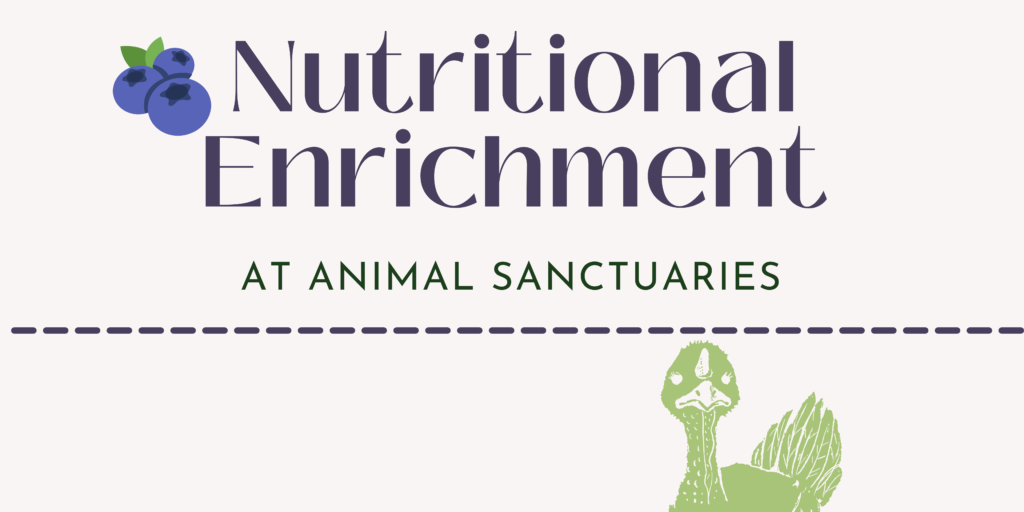
While sanctuary residents have many differences, there is one thing that most of them have in common: they love treats! Providing species-appropriate diets that meet residents’ nutritional and behavioral needs is vital to improving and ensuring their continued well-being. Of course, providing for basic diet needs, while important, isn’t the only way you can utilize food to promote residents’ well-being. Previously, our “Time To Thrive” series has covered several enrichment topics, including the importance of enrichment and categories of enrichment. In this resource, we will examine how nutritional enrichment can benefit residents. Let’s get started!
Nutritional Enrichment
Nutritional enrichment might be as simple as the act of providing different appropriate treats to individuals, or more complex, such as hiding food throughout living spaces or providing treats in puzzles or manipulable objects. It can also include the form in which food is offered, including adding treats to ice molds in summer months. As in other enrichment categories, how nutritional enrichment is offered will differ depending on the species and individual. For example, chickens may find pecking at a cabbage safely hung from the ceiling enriching, whereas pigs may find rooting for buried treats under the ground, under logs, or in rooting boxes enriching!
Highly Pathogenic Avian Influenza And Bird Residents
Due to the growing prevalence of HPAI, it is not recommended to allow bird residents access to food, water, or other resources that wild birds have access to. Learn more about how you can protect bird residents here.
Enrichment Overlap
As we cover nutritional enrichment, you will notice there will be an overlap in other areas of enrichment, such as sensory enrichment. (If you are unfamiliar with enrichment in general, check out this introductory resource.) An example of overlapping enrichment categories may look like giving goat residents access to goat-safe trees and shrubs in their outdoor living spaces. (You may find you have to protect the trees from over-exuberant snacking residents!) This provides nutritional enrichment and sensory enrichment, as well as physical enrichment.
A Buffet Of Experiences
Nutritional enrichment is an easy way to provide residents with variety and introduce opportunities for exploration and carrying out natural behaviors. While a daily diet provides necessary nutrients and most residents enjoy it, it doesn’t generally add anything different that might excite the senses and or bring new experiences to a resident’s life. Think about how exciting it is to enjoy a favorite dessert or try something new. Think of all the different textures you enjoy (or don’t!) and the delicious scents wafting from your kitchen. Simply seeing, smelling, and tasting something new can make your day more interesting. The same is true for residents!
When brainstorming ideas for nutritional enrichment, think about what their species and ancestors eat/ate in natural settings and how they acquire their food. Do they browse from various plants, such as grasses, leaves, and shrubs? Do they primarily graze on grasses? Do they use their long tongues or prehensile lips to select food? Do they look for food while they swim? Consider these species’ characteristics when considering what types of nutritional enrichment would work best for them. You can provide engaging opportunities for residents based on what makes sense for them as a species and individuals.
Remember The Individual
Always keep the individual in mind when brainstorming nutritional enrichment ideas! Age, mobility, health status, breed, and personality can all affect how a resident might safely interact with different types of nutrition enrichment.
Consider The Possibilities:
- Think high! Hang branches, hay balls, cabbages, treat piñatas, or puzzles.
- Go low! Scatter throughout straw or hay or in various substrates (not something that would cause impaction if ingested), around living areas, under logs, or in forage boxes.
- Make a splash! Put chopped or shredded produce in water buckets or pools so residents can bob or dive for treats.
- Brain food! Offer treats in food puzzles or create clicker learning activities that result in tasty treats.
Let’s look more closely at how a resident may experience nutritional enrichment:
A Resident’s Experience
Imagine you are Neptune, a duck resident. You have a daily routine where you eat a diet of pellets provided by caregivers in the morning; then, you spend the rest of your day in your outside living space. You might take a little swim in your pool or check out the mirror your caregivers placed outside the fence. Maybe you take a nice rest under bushes and enjoy the shade and a little quiet time away from a tour taking place in the distance. All in all, not a bad way to spend the morning.
Then you hear Scoots quacking and see Rosie hurry by. You follow them to see what the commotion is about and see that Casey, your caregiverSomeone who provides daily care, specifically for animal residents at an animal sanctuary, shelter, or rescue., is putting peas and shredded greens in the pool after cleaning and refilling it! You, Rosie, and Scoots spend a good deal of time swimming, diving for sunken veggies, and scooping greens off the top of the water. The water feels good, your pals are with you, there are plenty of treats to go around, and you are engaged in swimming and diving. What a treat! As time passes, caregivers provide various forms of enrichment, so there is often something different to explore or snack on, making your days new and interesting.

Now imagine that same scenario, except after eating your breakfast, you check out the mirror but aren’t sure what to make of it, so you waddle to the bushes for a little downtime. Later, your caregiver comes in and cleans the pool. You head their way to check things out and enjoy a nice swim when they refill the pool. You walk around a bit, looking for a snack or two, and find a cozy resting spot. Not a bad way to spend the day. You hung out with your buddies and took a swim. But the next day looks much the same and the day after that and so on.
As the above scenarios demonstrate, nutritional enrichment encourages residents to engage with their environment and perform natural behaviors. Even if both scenarios include physical enrichment, social enrichment, and sensory enrichment, providing nutritional enrichment for residents can make a big difference. Nutritional enrichment can awaken many senses and even be used as an element of cognitive enrichment. When a resident’s needs are unmet, this can have negative physical and psychological effects. Implementing enrichment as part of general care can help residents truly thrive. Nutritional enrichment is usually a hit with most residents when the species and individual are carefully considered.
Species-Specific Nutritional Enrichment: Inspiration
Now that we’ve looked at general concepts of nutritional enrichment let’s look at some inspiration for different species. You can also check out the links below to read tips about nutritional and other forms of enrichment for different species. Learning as much as possible about the species will help you develop successful enrichment strategies!
Alpacas
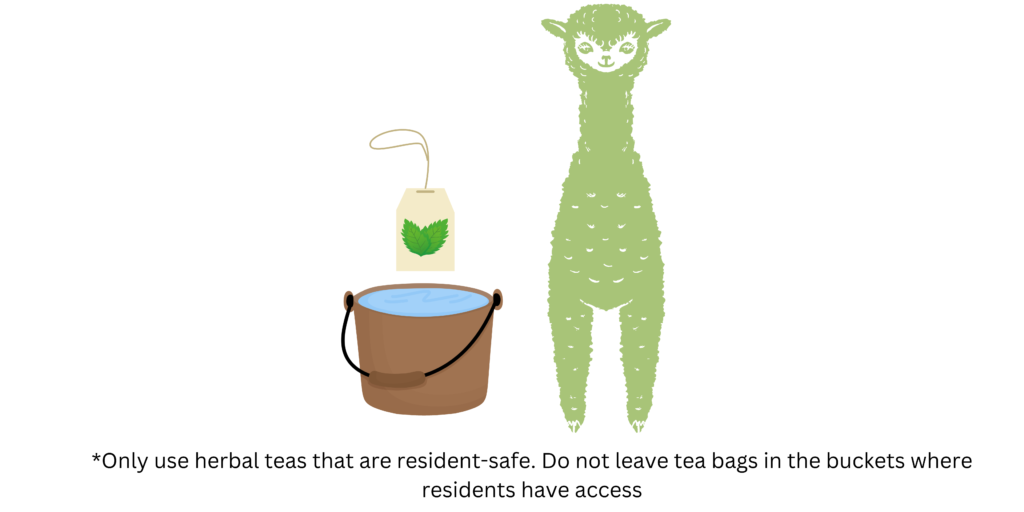
Here’s a list of ideas for nutritional enrichment for your alpaca residents:
- Take a 5-gallon bucket with a secure lid and make multiple holes in the sides. It becomes a food dispenser when the alpacas roll it.
- Add a pile of alpaca-safe leaves and sprinkle treats throughout.
- Offer alpaca-safe browse with tasty leaves for them to nibble. Alpacas will occasionally naturally browse in addition to grazing. Try to vary the heights when placing the browse.
- Drill holes in small, sturdy bowls, put a dowel through them (think paper towel dispenser), and secure it vertically to a wall or fence post. Place little treats in them so they can use their lips to manipulate the bowls to get a treat.
- Smear banana or other fruit mash on textured balls, large hanging pine cones, and other appropriate places.
- Grow safe herbs just outside the fence-line so they grow through, and residents can snack on them without destroying the whole plant. (fingers crossed!)
- Individual alpacas may exhibit a behavior called contrafreeloading. Contrafreeloading is the term for when an animal chooses to perform a task to receive food even when there is food readily available.
- You may be able to stimulate your alpaca residents into exhibiting this behavior by packing hay into a cardboard box with holes, feeding balls, or hiding treats in a container like the one mentioned above. Alpacas can solve logic puzzles, which can be used to promote increased feeding behavior, which requires some effort on their part- for their enjoyment!
- If you think hiding a resident’s food or making them work for their food is a negative experience for them (everyone is different), you can try an experiment with your residents: Provide a puzzle like the above or a cardboard box or another container that requires some manipulation to get their food and observe how your residents behave towards each. They will tell you if they find it engaging or not!
- When temperatures are hot, add chopped-up produce to a mold, water, and freeze, creating a cool treat that keeps your residents engaged on a hot day.
- Place fresh herbs, veggies, and fruits throughout their living spaceThe indoor or outdoor area where an animal resident lives, eats, and rests. so they can go on a scavenger hunt, encouraging movement and natural behaviors.
- Put alpaca-safe herbal tea bags (peppermint, ginger…etc.) in a water bucket with warm water and let them steep just enough to add some flavor, but not overwhelmingly so. Remove tea bags and place buckets throughout their living space. These should not replace regular drinking water.
- Bob for produce! Get a little swimming pool or something similar, add chopped-up treats, and fill it with water.
- Attach two hanging plant baskets together, creating a ball. Make space at the top of one half to add treats and forage and hang it to promote natural feeding behaviors. (Check carefully for any sharp or loose areas before using.) This is not appropriate for residents with respiratory issues, as dust from hay or other forage can aggravate their condition.
Chickens
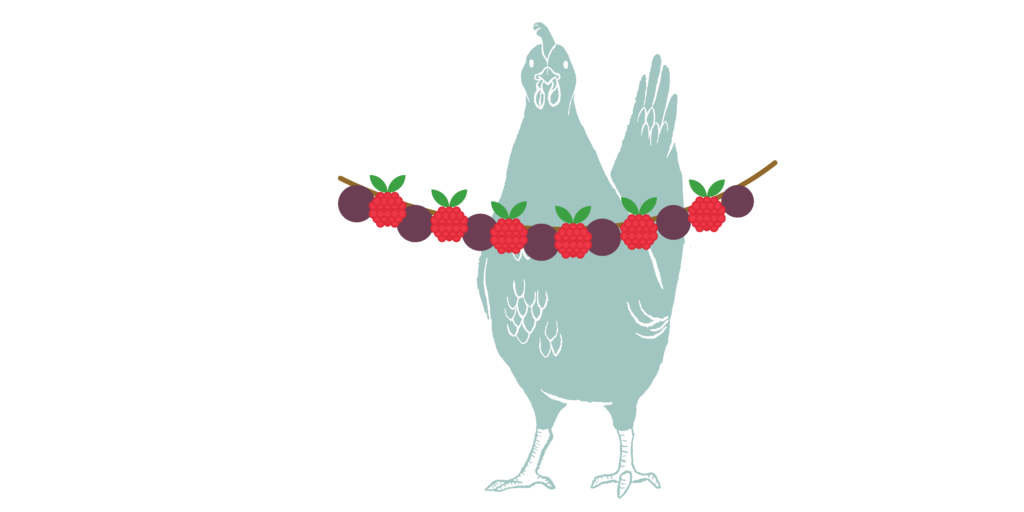
When providing enrichment for chicken residents, be sure you are following HPAI biosecurity guidelines.
Here is a list of ideas for nutritional enrichment for your chicken residents:
- Take a two to three-inch wide PVC pipe and put caps on the ends. The length of the tube could be twelve inches or larger. Drill a handful of holes in the side of the tube, and it becomes a food dispenser when the birds roll and peck at it.
- Another option is to place chicken food in wiffle balls. As the balls roll, treats fall out.
- Food balls are also made specifically for chickens that distribute a small amount of food when the ball is manipulated.
- Some puzzle feeders made for dogs can be used with supervision.
- Hang heads of cabbage or lettuce from a string, making a tasty treat piñata! We recommend covering the string with stiff tubing or a piece of hose to prevent residents from getting tangled in the string.
- Add a pile of leaves (be sure they aren’t toxic to chickens) and sprinkle treats throughout.
- String safe produce and make a garland to hang in their living space.
- Chickens are an amazing species that exhibit a behavior called contrafreeloading. Contrafreeloading is the term for when an animal will choose to perform a task to receive food even when there is food readily available. This is most evidently seen in red jungle fowl, from which domesticatedAdapted over time (as by selective breeding) from a wild or natural state to life in close association with and to the benefit of humans chickens descend. Red jungle fowl exhibit this behavior most, with domesticated chickens following, though large breedDomesticated animal breeds that have been selectively bred by humans to grow as large as possible, as quickly as possible, to the detriment of their health. chickens tend to exhibit less of this behavior. See an example of a chicken performing a task for food here.
- If you think hiding a bird’s food or making them work for their food is unkind, you can try an experiment with your residents. Provide a puzzle with food in it next to a bowl of food, and see how your residents behave.
- When temperatures are hot, add chopped-up produce to a mold, water, and freeze, creating a cool treat that keeps your residents engaged on a hot day.
Check out our resource on safe treats for chicken residents here!
Chicken Resident Safety
While a common practice at many sanctuaries and directly experienced by our staff members, we received a concerning report from a sanctuary that frozen treats caused internal injury to several chicken residents. Staff reports that their veterinarian listed tissue damage from frostbite, pain/cold sensitivity, and localized hypothermia as potential health concerns from feeding birds frozen treats. They recommended offering refrigerated treats instead. We are looking into it and will update our guidance as we learn more! Please reach out to us if you have experienced this at your sanctuary.
Cows
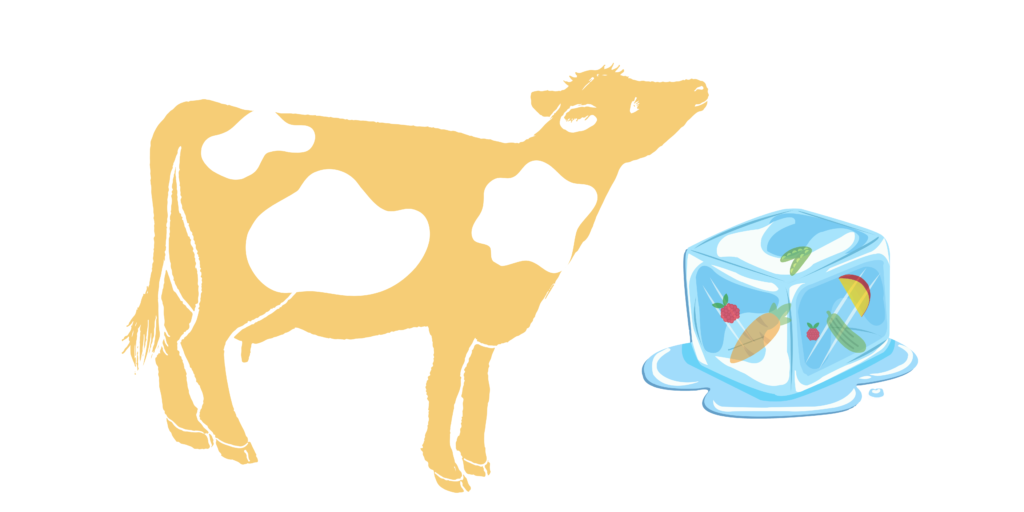
Here is a list of ideas for nutritional enrichment for your cowWhile "cow" can be defined to refer exclusively to female cattle, at The Open Sanctuary Project we refer to domesticated cattle of all ages and sexes as "cows." residents:
- Take a large office water jug and drill a handful of holes in the side of the jug. This transforms the jug into a food dispenser when the cowsWhile "cows" can be defined to refer exclusively to female cattle, at The Open Sanctuary Project we refer to domesticated cattle of all ages and sexes as "cows." roll and nudge it!
- Another option is to place treats that can be easily grasped with their tongues in large wiffle-type balls and attach them to fencing with zip ties throughout the living space (but cut off the tail of the zip tie to prevent cow residents from eating them and be sure the ball couldn’t be swallowed in case they remove them!).
- Enrichment can even be less expensive than the above to make! Take a cardboard box, put holes in it, put treats inside, and place them in the living space!
- Smear banana or other fruit mash on large balls, logs, and other appropriate places. Varying heights help promote natural behavior.
- Or make paper mache piñatas full of yummy treats!
- You can use solid, rounded receptacles with holes punched through them as a do-it-yourself hay roller!
- During the fall, you can ask for non-rotten pumpkin donations, which also make a fun treat! Just make sure that potentially painted-on areas are removed before feeding them.
- A fun summer enrichment idea is to take a tub of water, chop up cow-friendly produce, and let them bob for treats!
- When temperatures are especially hot, add chopped-up produce to a mold, water, and freeze, creating a cool treat that keeps your residents engaged on a hot day. While cows usually have their heads to the ground as grazers, you can experiment with placing a bit of rope into the mold as well and hanging it for them to investigate and nibble!
- Put cow-safe herbal tea bags (peppermint, ginger, etc.) in a water bucket with warm water and let them steep just enough to add some flavor, but not overwhelmingly so. Remove tea bags and place buckets throughout their living space. These should not replace regular drinking water.
Donkeys
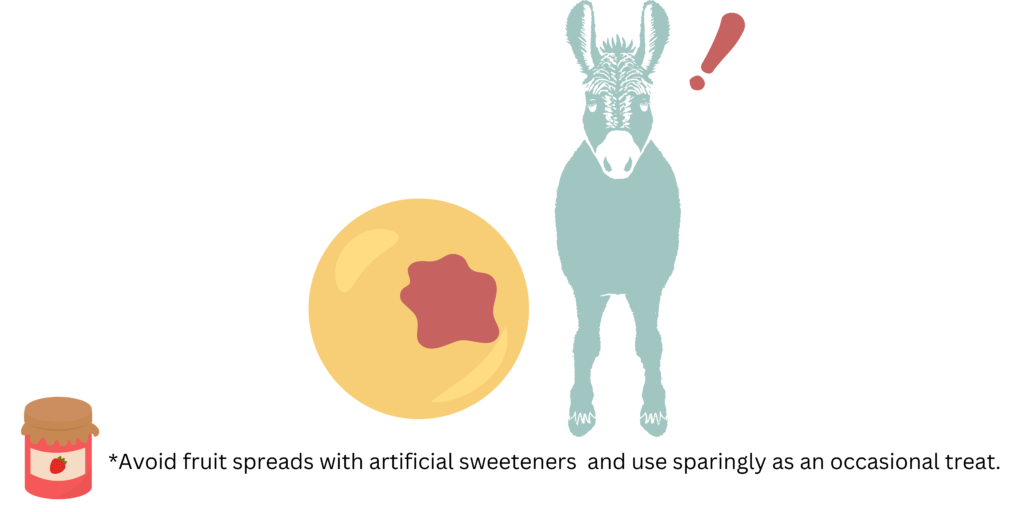
Here’s a list of ideas for nutritional enrichment for your donkey residents:
- Take a 5-gallon bucket with a secure lid or a plastic barrel and make multiple holes in the sides. It becomes a food dispenser when the donkeys roll it.
- Add a pile of donkey-safe leaves and sprinkle treats throughout.
- Offer donkey-safe branches with tasty leaves for them to nibble. Donkeys naturally browse in addition to grazing. Try to vary the heights when placing the browse.
- Place fresh logs throughout their outdoor living space so they can chew and tear the bark off.
- Smear banana or other fruit mash on balls, logs, and other appropriate places. Varying heights help promote natural behavior.
- Grow donkey-safe herbs just outside the fence line, so they grow through, and residents can snack on them without destroying the whole plant (fingers crossed!)
- Individual donkeys may exhibit a behavior called contrafreeloading. Contrafreeloading is the term for when an animal chooses to perform a task to receive food even when there is food readily available.
- You may be able to stimulate your donkey residents into exhibiting this behavior by packing hay into a cardboard box with holes, feeding balls, or hiding treats in a container like the one mentioned above. Donkeys can solve logic puzzles, which can be used to promote increased feeding behavior that requires some effort on their part- for their enjoyment! A resident can pull or lift wooden boxes with hinged lids or drawers with the rope attached to gain access to their treat.
- If you think hiding a resident’s food or making them work for their food is a negative experience for them (everyone is different), you can try an experiment with your residents: Provide a puzzle as described above or a cardboard box or other container that requires some manipulation to get their food, and observe how your residents behave towards each. They will tell you if they find it engaging or not!
- When temperatures are hot, add chopped-up produce to a mold, water, and freeze, creating a cool treat that keeps your residents engaged on a hot day.
- Place fresh herbs, veggies, and fruits throughout a donkey’s living space so they can go on a scavenger hunt, encouraging movement and natural behaviors.
- Put donkey-safe herbal tea bags (peppermint, ginger, etc.) in a water bucket with warm water and let them steep just enough to add some flavor, but not overwhelmingly so. Remove tea bags and place buckets throughout their living space. These should not replace regular drinking water.
- Bob for produce! Get a little swimming pool or something similar, add chopped-up treats, and fill it with water.
- Attach two hanging plant baskets together, creating a ball. Make space at the top of one half to add treats and forage and hang it to promote natural feeding behaviors. (Check carefully for any sharp or loose areas before using.) This is not appropriate for residents with respiratory issues, as dust from hay or other forage can aggravate their condition.
Ducks
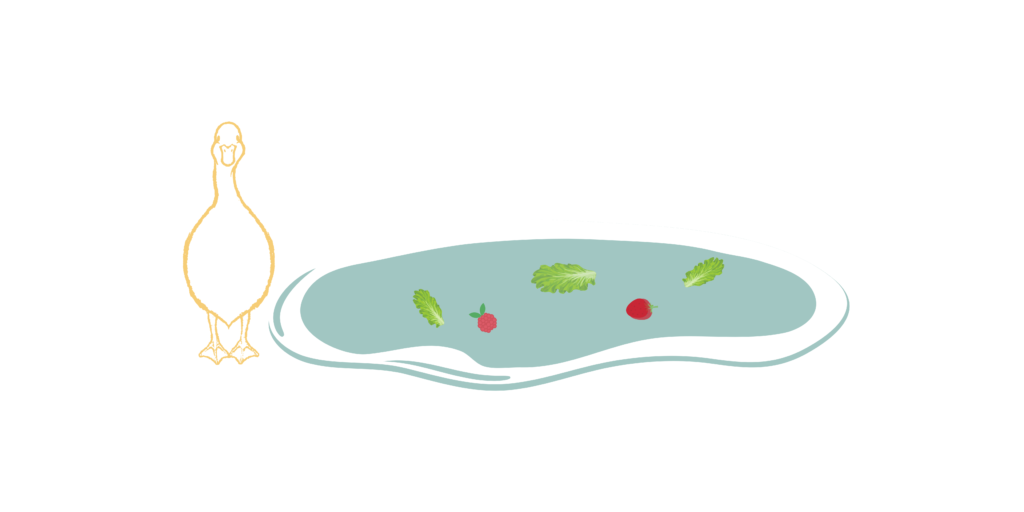
When providing enrichment for duckUnless explicitly mentioned, we are referring to domesticated duck breeds, not wild ducks, who may have unique needs not covered by this resource. residents, be sure you follow HPAI biosecurity guidelines.
Here is a list of ideas for nutritional enrichment for your duck residents:
- Take a two to three-inch wide PVC pipe and put caps on the ends. The length of the tube could be a foot long or larger. Drill a handful of holes in the side of the tube, and it becomes a food dispenser when residents roll and peck at it.
- Another option is to place a duck’s food in wiffle balls. As the balls roll, treats fall out. Or, you can hang the wiffle balls.
- There are also food balls made specifically for chickens that distribute a small amount of food when the ball is manipulated. It can work for ducksUnless explicitly mentioned, we are referring to domesticated duck breeds, not wild ducks, who may have unique needs not covered by this resource. too.
- Some puzzle feeders made for dogs can be used with supervision.
- Provide forage boxes, or fence off an area inside their enclosure and plant duck-safe plants, then remove the barrier and let them forage in the new space.
- Hang heads of cabbage or lettuce from a string or in a ball basket, making a tasty treat piñata! We recommend covering the string with stiff tubing or a piece of hose to prevent residents from getting tangled in the string.
- Add a pile of leaves (be sure they aren’t toxic to ducks) and sprinkle treats throughout.
- String produce and make a garland to hang in their living space.
- When temperatures are hot, add chopped-up produce to a mold, water, and freeze, creating a cool treat that keeps your residents engaged on a hot day.
- Add greens to water, and you can even place a rock on top of greens at the bottom of a pool for them to dive for!
Geese
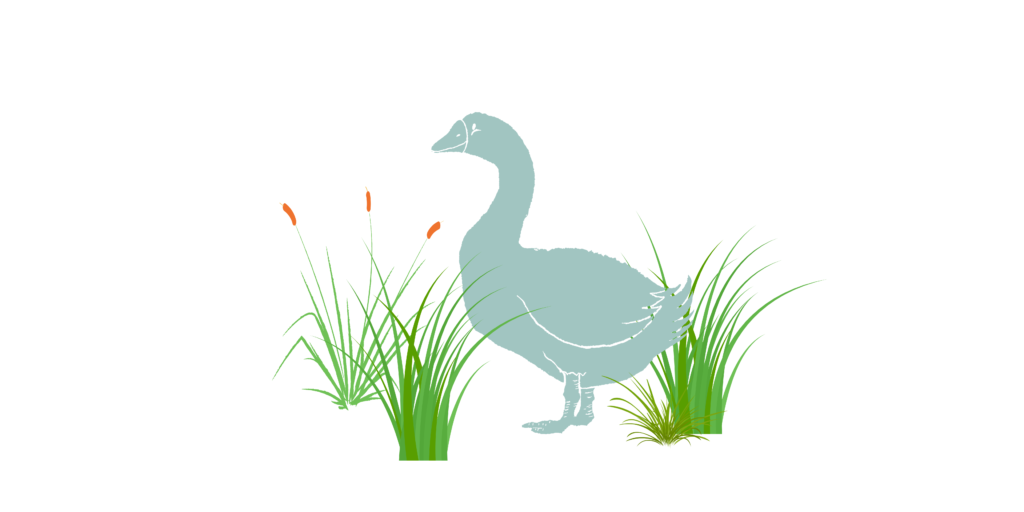
When providing enrichment for geeseUnless explicitly mentioned, we are referring to domesticated goose breeds, not wild geese, who may have unique needs not covered by this resource. residents, be sure you follow HPAI biosecurity guidelines.
Here is a list of ideas for nutritional enrichment for your geese residents:
- Geese are grazers and love new grass. You can give them new grass and goose-safe plants to graze on.
- Take a two to three-inch wide PVC pipe and put caps on the ends. The length of the tube could be a foot long or larger. Drill a handful of holes in the side of the tube, and it becomes a food dispenser when the birds roll and peck at it.
- Another option is to place a goose’s food in wiffle balls. As the balls roll, treats fall out. Or, you can hang the wiffle balls.
- Some puzzle feeders made for dogs can be used with supervision.
- Provide forage boxes, or fence off an area inside their enclosure and plant goose-safe plants, then remove the barrier and let them forage in the new space.
- Hang heads of cabbage or lettuce from a string or in a ball basket, making a tasty treat piñata! We recommend covering the string with stiff tubing or a piece of hose to prevent residents from getting tangled in the string.
- Add a pile of leaves (be sure they aren’t toxic to geese) and sprinkle treats throughout.
- String produce and make a garland to hang in their living space.
- When temperatures are hot, add chopped-up produce to a mold, water, and freeze, creating a cool treat that keeps your residents engaged on a hot day.
Check out our resource on safe treats for geese residents!
Goats
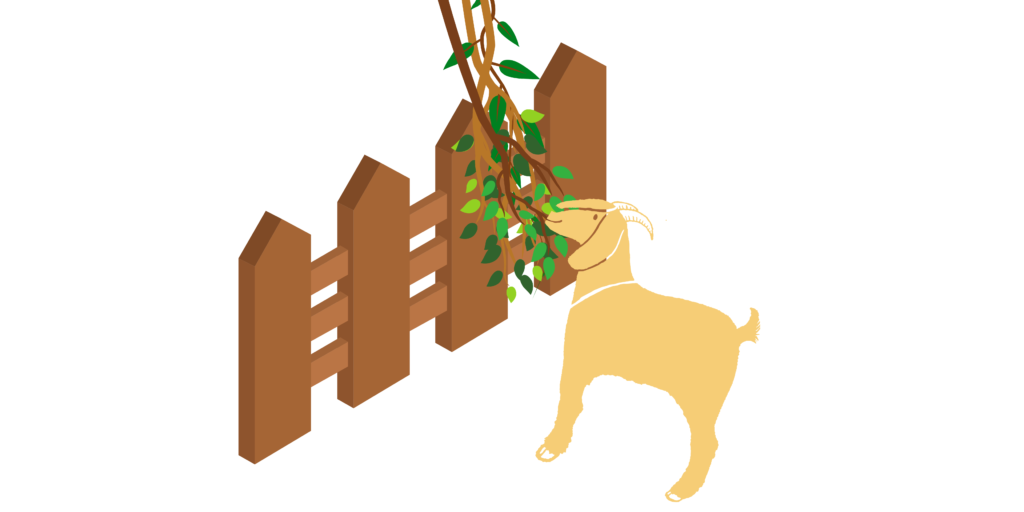
Here is a list of nutritional enrichment strategies for your goat residents:
- Take a PVC pipe and put caps on the ends. The length of the tube can be a foot long or larger. Drill a handful of holes in the side of the tube, and it becomes a food dispenser. You can attach these dispensers to a fence or post, put leafy greens through them, and hang them at different heights to stimulate natural browsing behaviors. You can make PVC “tree branches” and hang them from a ceiling, from goat furniture, or an actual tree!
- Another option is to place goats’ food in wiffle balls or other goat-safe treat balls. As the balls roll, treats fall out.
- In the summer, chop up goat-safe treats and freeze them in a big container filled with water for a treat that keeps on giving! This has the added bonus of helping residents stay cool.
- Some puzzle feeders made for dogs can be used for goat residents with supervision.
- Or make paper mache piñatas full of yummy treats or hang whole pieces of produce from a rope in their living space.
- Hang hay feeders and branches to encourage movement and browsing behavior.
- Hollow out a pumpkin and put treats inside.
- Gather a pile of leaves (be sure they aren’t toxic) and sprinkle treats throughout.
- As a species, goats have exhibited a behavior called contrafreeloading. Contrafreeloading means an animal will choose to perform a task to receive food or another resource, even when food is readily available. If you think hiding a goat’s food or making them work for their food is teasing, or they don’t like it, you should try an experiment: Set out a puzzle with food in it next to a bowl of food and see where your goat residents migrate to!
Check out our resource on safe treats for goat residents here!
Horses
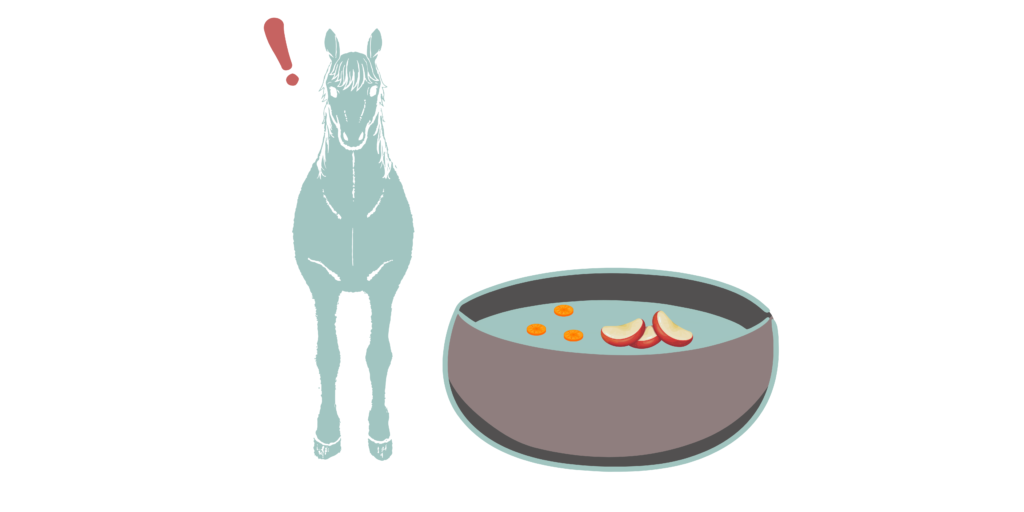
Here’s a list of ideas for nutritional enrichment for your horse residents:
- Take a 5-gallon bucket with a secure lid or a plastic barrel and make multiple holes in the sides. It becomes a food dispenser when the residents roll it.
- Add a pile of horse-safe leaves and sprinkle treats throughout.
- Grow safe herbs just outside the fence line, so they grow through, and residents can snack on them without destroying the whole plant (fingers crossed!)
- Individual horses may exhibit a behavior called contrafreeloading. Contrafreeloading is the term for when an animal chooses to perform a task to receive food even when there is food readily available.
- You may be able to stimulate your horse residents into exhibiting this behavior by packing hay into a cardboard box with holes, feeding balls, or hiding treats in a container like the one mentioned above. Horses can solve logic puzzles, which can be used to promote increased feeding behavior that requires some effort on their part- for their enjoyment! A resident can pull or lift wooden boxes with hinged lids or drawers with a rope attached to gain access to their treat.
- If you think hiding a resident’s food or making them work for their food is a negative experience for them (everyone is different), you can try an experiment with your residents: Provide a puzzle as described above or a cardboard box or other container that requires some manipulation to get their food, and observe how your residents behave towards each. They will tell you if they find it engaging or not!
- When temperatures are hot, add chopped-up produce to a mold, water, and freeze, creating a cool treat that keeps your residents engaged on a hot day.
- Place fresh herbs, veggies, and fruits throughout a horse’s living space so they can go on a scavenger hunt, encouraging movement and natural behaviors.
- Put horse-safe herbal tea bags (peppermint, ginger, etc.) in a water bucket with warm water and let them steep just enough to add some flavor, but not overwhelmingly so. Remove tea bags and place buckets throughout their living space. These should not replace regular drinking water.
- Bob for produce! Get a little swimming pool or something similar, add chopped-up treats, and fill it with water.
- Attach two hanging plant baskets together, creating a ball. Make space at the top of one half so you can add treats and forage and hang it securely. (Check carefully for any sharp or loose areas before using.) This is not appropriate for residents with respiratory issues, as dust from hay or other forage can aggravate their condition.
Llamas
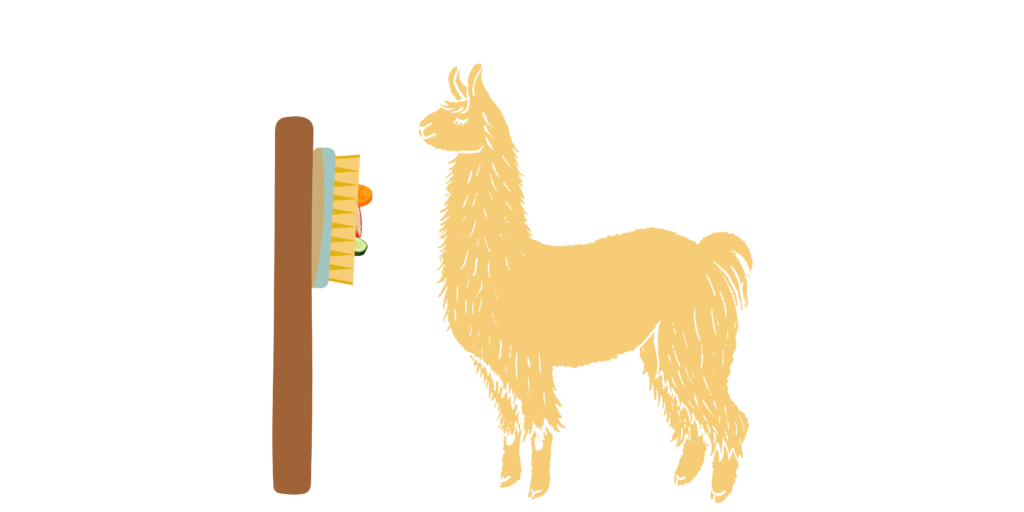
Here’s a list of ideas for nutritional enrichment for your llama residents:
- Take a 5-gallon bucket with a secure lid and make multiple holes in the sides. It becomes a food dispenser when the llamas roll it.
- Add a pile of llama-safe leaves and sprinkle treats throughout.
- Offer llama-safe branches with tasty leaves for them to nibble. Llamas naturally browse in addition to grazing. Try to vary the heights when placing the browse.
- Drill holes in small, sturdy bowls, put a dowel through them (think paper towel dispenser), and secure it vertically to a wall or fence post. Place little treats in them so they can use their lips to manipulate the bowls to get a treat.
- Smear banana or other fruit mash on textured balls, large hanging pine cones, and other appropriate places.
- Grow safe herbs just outside the fence line so they grow through, and residents can snack on them without destroying the whole plant. (fingers crossed!)
- Individual llamas may exhibit a behavior called contrafreeloading. Contrafreeloading is the term for when an animal chooses to perform a task to receive food even when there is food readily available.
- You may be able to stimulate your llama residents into exhibiting this behavior by packing hay into a cardboard box with holes, feeding balls, or hiding treats in a container like the one mentioned above. Llamas can solve logic puzzles, which can be used to promote increased feeding behavior, and that requires some effort on their part- for their enjoyment!
- If you think hiding a resident’s food or making them work for their food is a negative experience for them (everyone is different), you can try an experiment with your residents: Provide a puzzle like the above or a cardboard box or other container that requires some manipulation to get their food and observe how your residents behave towards each. They will tell you if they find it engaging or not!
- When temperatures are hot, add chopped-up produce to a mold, water, and freeze, creating a cool treat that keeps your residents engaged on a hot day.
- Place fresh herbs, veggies, and fruits throughout their living space so they can go on a scavenger hunt, encouraging movement and natural behaviors.
- Put llama-safe herbal tea bags (peppermint, ginger…etc.) in a water bucket with warm water and let them steep just enough to add some flavor, but not overwhelmingly so. Remove tea bags and place buckets throughout their living space. These should not replace regular drinking water.
- Bob for produce! Get a little swimming pool or something similar, add chopped-up treats, and fill it with water.
- Attach two hanging plant baskets together, creating a ball. Make space at the top of one half to add treats and forage and hang it to promote natural feeding behaviors. (Check carefully for any sharp or loose areas before using.) This is not appropriate for residents with respiratory issues, as dust from hay or other forage can aggravate their condition.
Pigs
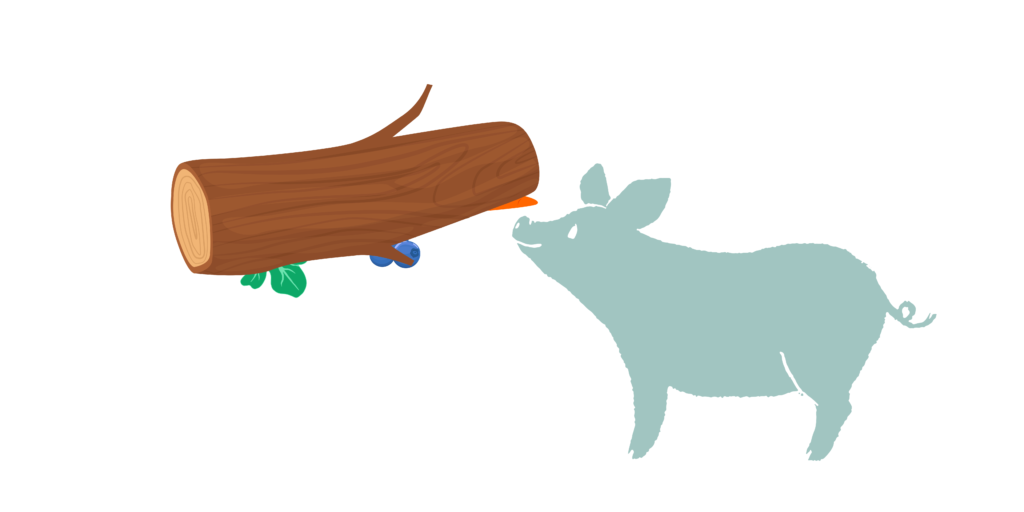
Here is a list of ideas for nutritional enrichment for your pig residents:
- Instead of offering treats in a bowl, bury bits of produce throughout their living space so they can use their snouts to root around and find their treat. This encourages residents to explore their living spaces, exercise more, and promote cognitive development.
- If you don’t have living spaces where your pig residents can dig, don’t worry! Add a kiddie pool or build a wooden rooting area. This can have large smooth stones in it, pack dirt or straw, or bits of branches and other pig-safe debris for residents to dig through. Once you have this, you can hide treats in the rooting area for them to dig up. This one is almost guaranteed to be a hit with your residents!
- Take a large water jug and drill a handful of holes in the side of the jug. This transforms the jug into a food dispenser when the pigs roll and nudge it!
- Another option is to build a stand (design it for the size and temperament of your pig residents) and attach a pole going across the stand that has several bottles (water bottles, soda bottles, and others) stung across it. Put treats or grain supplements within so residents have to manipulate them to get the treats to fall out. This is great cognitive stimulation and extends the time they get to eat their tasty treats.
- You can also attach a long rollable PVC pipe with holes cut out to a sturdy wooden base for residents to manipulate with their noses for treats. (Think of a heavy-duty paper towel dispenser!)
- You can also use sturdy dog treat dispensing toys like Kongs with supervision. Just be sure parts cannot be accidentally consumed, and regularly inspect them for any damage.
- Another option is a snuffle mat. This is a mat made with material knotted through floor mats that leaves excess material on the top of the mat. Treats can be sprinkled throughout the mat to encourage exploration and natural rooting behaviors. Here is a link to easy instructions from Dogs Trust UK (Yes, dogs can love this too!)
- Enrichment can be less expensive than the above! Take a cardboard box, put holes in it, put treats inside, and place them in the living space!
- Or make paper mache pinatas full of yummy treats or hang whole pieces of produce from a rope in their living space.
- During the fall, you can ask for non-rotten pumpkin donations, which also make a fun treat! Just make sure that potentially painted-on or inked areas are removed before feeding them.
- A fun summer enrichment idea is to take a tub of water, chop up pig-friendly produce, and let them bob for treats!
- When temperatures are especially hot, add chopped-up produce to a mold, water, and freeze, creating a cool treat that keeps your residents engaged on a hot day. While pigs usually have their heads to the ground as grazers, you can experiment with placing a bit of rope into the mold as well and hanging it for them to investigate and nibble!
Rabbits

Here is a list of ideas for nutritional enrichment for your rabbit residents:
- Take a two to three-inch wide PVC pipe and put caps on the ends. Drill a handful of holes in the side of the tube, and it becomes a food dispenser when the rabbitsUnless explicitly mentioned, we are referring to domesticated rabbit breeds, not wild rabbits, who may have unique needs not covered by this resource. roll it.
- Another option is to place rabbitUnless explicitly mentioned, we are referring to domesticated rabbit breeds, not wild rabbits, who may have unique needs not covered by this resource. treats in wiffle balls. As the balls roll, treats fall out.
- Some puzzle feeders made for dogs can be used for rabbit residents with supervision. Or make your own!
- Hang greens up high.
- Add a pile of rabbit-safe leaves and sprinkle treats throughout.
- Individual rabbits may exhibit a behavior called contrafreeloading. Contrafreeloading is the term for when an animal chooses to perform a task to receive food even when there is food readily available.
- You may be able to stimulate your rabbit residents into exhibiting this behavior by packing hay into a cardboard box with holes or hiding treats in an old oatmeal container. Rabbits can solve logic puzzles, which can be used to promote foraging behavior that requires some effort on their part- for their enjoyment! Small boxes with lids, rabbit-safe material, and tiny rabbit-sized drawers with a rope attached could lead a rabbit to learn to pull on the rope to get the desired treat!
- If you think hiding a rabbit’s food or making them work for their food is unkind, you can try an experiment with your residents: Provide a puzzle with food in it next to a bowl of food, and see how your residents behave towards each. They will tell you if they find the puzzle engaging or not!
- When temperatures are hot, add chopped-up produce to a mold, water, and freeze, creating a cool treat that keeps your residents engaged on a hot day.
Sheep
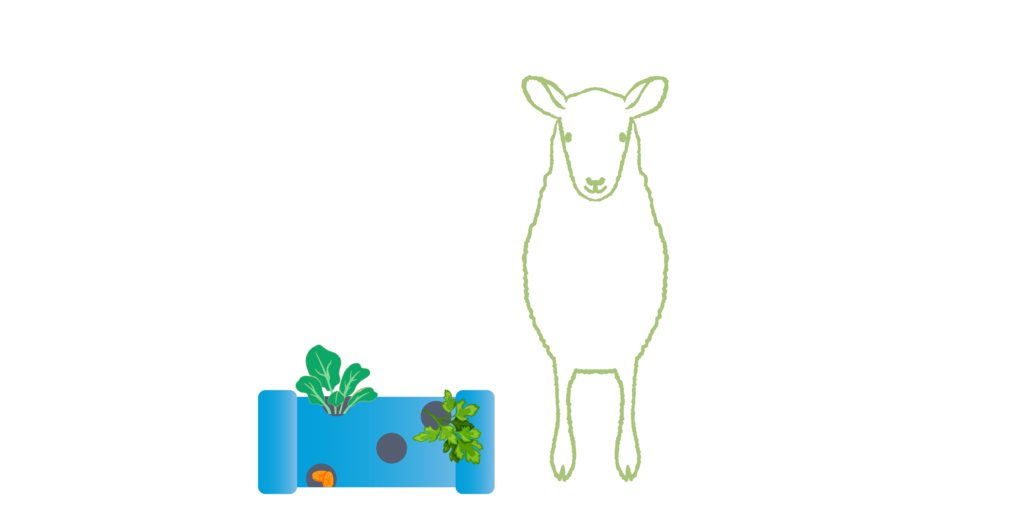
Here is a list of potential nutritional enrichment strategies for your sheep residents:
- Take a PVC pipe and put caps on the ends. The length of the tube can be a foot long or larger. Drill a handful of holes in the side of the tube, and it becomes a food dispenser.
- Another option is to place sheep food in wiffle balls or other sheep-safe treat balls. As the balls roll, treats fall out.
- In the summer, chop up treats and freeze them in a big container filled with water for a treat that keeps on giving! This has the added bonus of helping residents stay cool.
- Some puzzle feeders made for dogs can be used with supervision.
- Add a pile of leaves (be sure they aren’t toxic) and sprinkle treats throughout.
- Hollow out a pumpkin and put treats inside.
- Hide bundles of fresh, sheep-safe herbs around their living area.
- Make a garland! String produce using a strong but thinner length of rope and cover it with non-toxic plastic tubing, then cut holes in produce and string along the tube and securely attach to sturdy structures like fence posts. Ensure sheep residents do not chew through the string, as this could cause harm to them!
- Provide forage boxes, or fence off an area inside their enclosure and plant sheep-safe plants, then remove the barrier and let them forage in the new space.
Turkeys
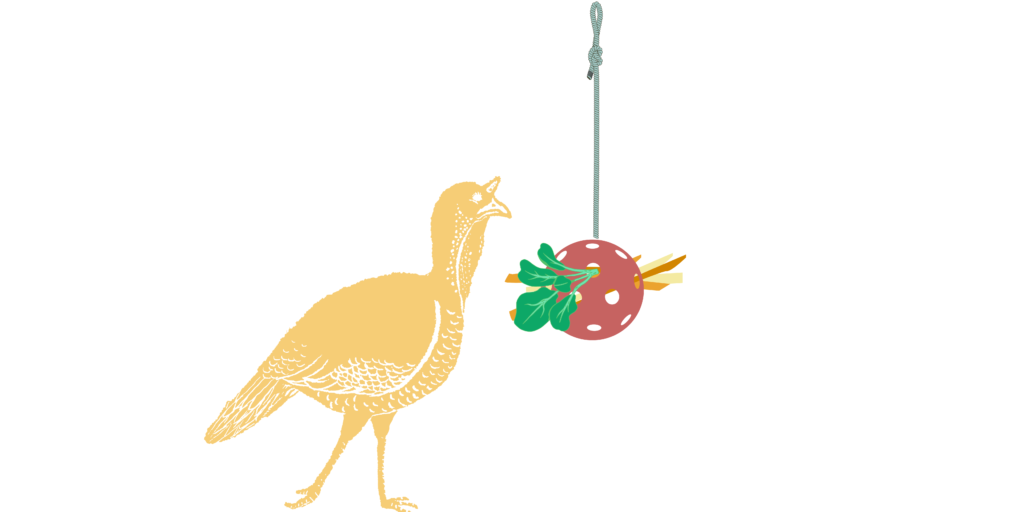
When providing enrichment for turkeyUnless explicitly mentioned, we are referring to domesticated turkey breeds, not wild turkeys, who may have unique needs not covered by this resource. residents, be sure you follow HPAI biosecurity guidelines.
Here is a list of ideas for nutritional enrichment for your turkey residents:
- Take a two to three-inch wide PVC pipe and put caps on the ends. Drill a handful of holes in the side of the tube, and it becomes a food dispenser when residents roll and peck at it.
- Another option is to place turkey food in wiffle balls. As the balls roll, treats fall out.
- Food balls are also made specifically for chickens that distribute a small amount of food when the ball is manipulated. This can work for turkey reisdents too!
- Some puzzle feeders made for dogs can be used with supervision.
- Hang heads of cabbage or lettuce from a string, making a tasty treat piñata! We recommend covering the string with stiff tubing or a piece of hose to prevent residents from getting tangled in the string.
- Add a pile of leaves (be sure they aren’t toxic to turkeys) and sprinkle treats throughout.
- String produce and make a garland to hang in their living space.
- When temperatures are hot, add chopped-up produce to a mold, water, and freeze, creating a cool treat that keeps your residents engaged on a hot day.
Check out our resource on safe treats for turkey residents!
We hope this resource inspires you to devise creative ways to provide nutritional enrichment for your residents. Remember that nutritional enrichment strategies, like all other forms of enrichment, are only enriching if a resident finds it so. A resident who is uninterested, fearful, or upset at proffered enrichment is not having an enriching experience!
SOURCES:
The Stimulating Science Of Animal Enrichment | Untamed Science
Five Enrichment Categories | The Shape Of Enrichment
Guidelines For General Species Environmental Enrichment | NIH (Non-Compassionate Source)
Non-Compassionate Source?
If a source includes the (Non-Compassionate Source) tag, it means that we do not endorse that particular source’s views about animals, even if some of their insights are valuable from a care perspective. See a more detailed explanation here.






